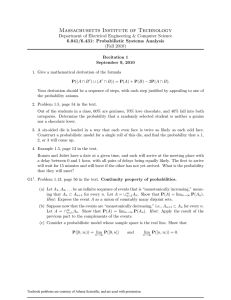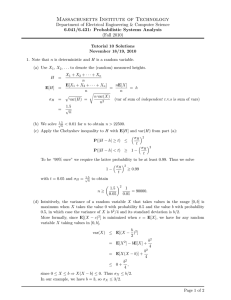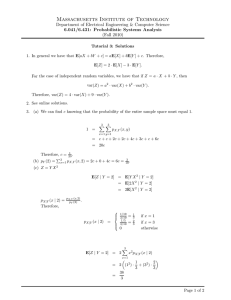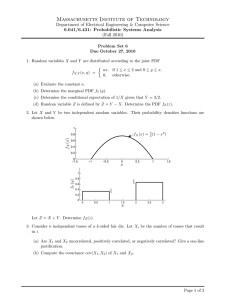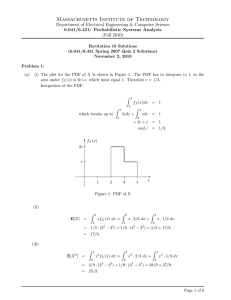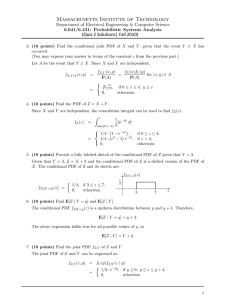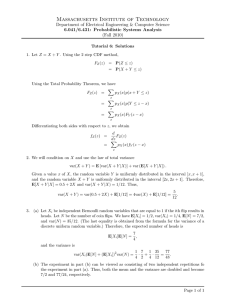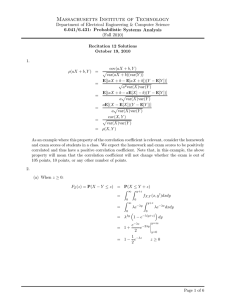Massachusetts Institute of Technology
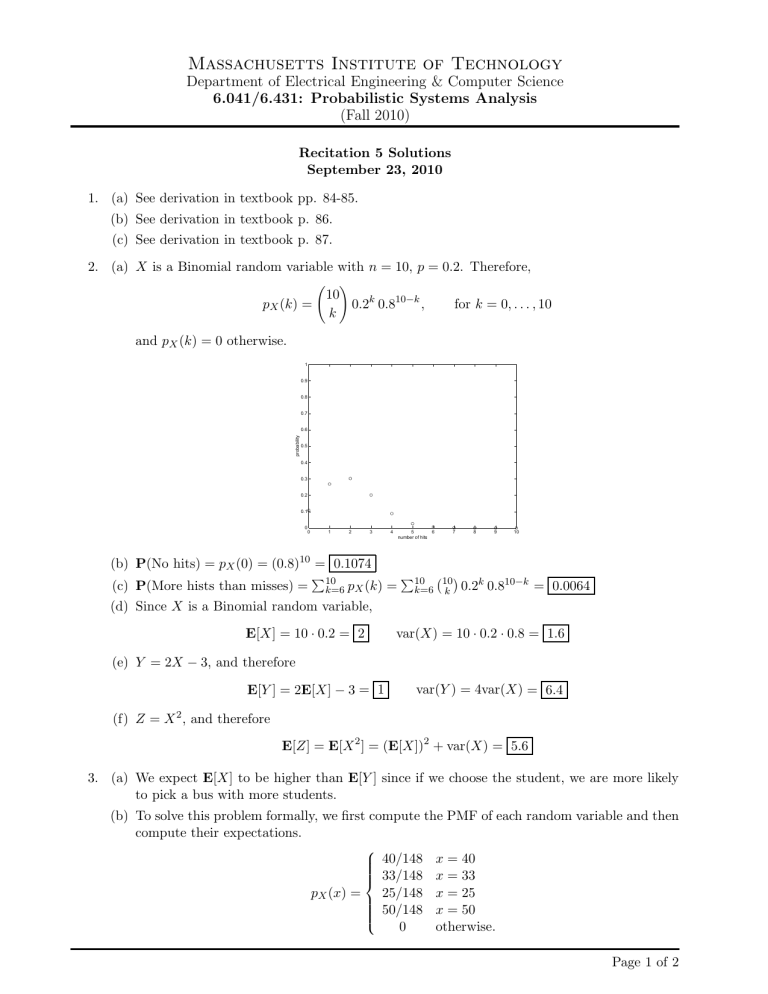
Massachusetts Institute of Technology
Department of Electrical Engineering & Computer Science
6.041/6.431: Probabilistic Systems Analysis
(Fall 2010)
Recitation 5 Solutions
September 23, 2010
1. (a) See derivation in textbook pp. 84-85.
(b) See derivation in textbook p. 86.
(c) See derivation in textbook p. 87.
2. (a) X is a Binomial random variable with n = 10, p = 0 .
2. Therefore, p
X
( k ) =
10
!
0 .
2 k k
0 .
8
10
− k
, for k = 0 , . . . , 10 and p
X
( k ) = 0 otherwise.
0.7
0.6
0.5
0.4
1
0.9
0.8
0.3
0.2
0.1
0
0 1 2 3 4 5 number of hits
6 7 8 9 10
(b) P (No hits) = p
X
(0) = (0 .
8) 10 = 0.1074
(c) P (More hists than misses) = P
10 k =6 p
X
( k ) = P
10 10 k =6 k
(d) Since X is a Binomial random variable,
0 .
2 k 0 .
8 10
− k = 0.0064
E [ X ] = 10
·
0 .
2 = 2 var( X ) = 10
·
0 .
2
·
0 .
8 = 1.6
(e) Y = 2 X
−
3, and therefore
E [ Y ] = 2 E [ X ]
−
3 = 1
(f) Z = X 2 , and therefore var( Y ) = 4var( X ) = 6.4
E [ Z ] = E [ X
2
] = ( E [ X ])
2
+ var( X ) = 5.6
3. (a) We expect E [ X ] to be higher than E [ Y ] since if we choose the student, we are more likely to pick a bus with more students.
(b) To solve this problem formally, we first compute the PMF of each random variable and then compute their expectations. p
X
40
33
/
/
148
148 x x
= 40
= 33
( x ) = 25 / 148 x = 25
50 / 148 x = 50
0 otherwise .
Page 1 of 2
Massachusetts Institute of Technology
Department of Electrical Engineering & Computer Science
6.041/6.431: Probabilistic Systems Analysis
(Fall 2010) and E [ X ] = 40 40
148
+ 33 33
148
+ 25 p
Y
( y
25
148
+ 50
(
) =
1 / 4 y = 40 , 33 , 25 , 50
0
50
148
= 39 .
28 otherwise .
and E [ Y ] = 40
1
4
+ 33
Clearly, E [ X ] > E [ Y ].
1
4
+ 25
1
4
+ 50
1
4
= 37
4. The expected value of the gain for a single game is infinite since if X is your gain, then
∞
X
2 k
·
2 − k
∞
X
= 1 =
∞ k =1 k =1
Thus if you are faced with the choice of playing for given fee f or not playing at all,and your objective is to make the choice that maximizes your expected net gain, you would be willing to pay any value of f . However, this is in strong disagreement with the behavior of individuals. In fact experiments have shown that most people are willing to pay only about $20 to $30 to play the game. The discrepancy is due to a presumption that the amount one is willing to pay is determined by the expected gain. However, expected gain does not take into account a persons attitude towards risk taking.
Below are histograms showing the payout results for various numbers of simulations of this game:
20 simulations, observed average = $19.20
15
10
5
0
0
150
100
50
0
0
50 100 150 200
200 simulations, observed average = $11.16
250
100 200 300 400 500
300
600
Page 2 of 2
MIT OpenCourseWare http://ocw.mit.edu
6.041SC Probabilistic Systems Analysis and Applied Probability
Fall 2013
For information about citing these materials or our Terms of Use, visit: http://ocw.mit.edu/terms .
